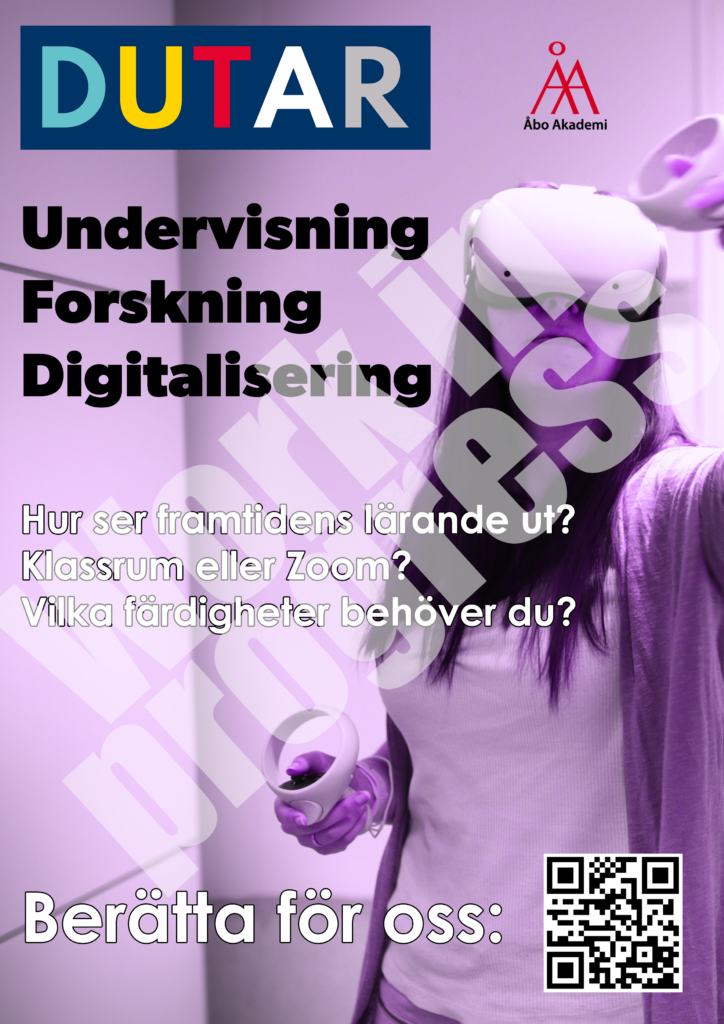Author: Ilia Gugenishvili
Åbo Akademi University’s VR Integration
Virtual Reality (VR) has ushered in a transformative era in education, particularly in disciplines such as engineering and computer science, yet its potential remains largely unexplored in other fields, such as business and education. This untapped potential is evident in the challenges posed by VR: its expansiveness, perceived difficulty of use, and the time-consuming nature of its creation and implementation for different purposes. Regardless of these challenges, Åbo Akademi University (ÅAU), supported by the project Digitalization of education for accessibility, attractiveness, and relevance (Swe. Digitalisering av undervisningen för tillgänglighet, attraktion och relevans; DUTAR), has embraced VR, incorporating it into various courses.
One such example is the course ‘Introduction to Marketing’. The course is offered to international bachelor’s and master’s degree students and one of its objectives is to develop competent communicators. To reach this objective, VR is used as a tool. Next, I will detail the role of VR in the course, how implementation was designed, and which experiences VR introduced for the course participants.
Four Stages of the Course
The VR workshops, conducted at ÅAU’s XR lab in the ASA-building, utilized the Virtual Speech application with Meta Quest 3 headsets. This AI-powered software supports different courses and exercises, providing feedback to improve soft skills such as participating in interviews, networking, expressing empathy, and delivering impactful presentations.
Soft skills, often referred to as interpersonal skills or emotional intelligence, play a vital role in enhancing interactions, job performance, and career prospects. Unlike technical or hard skills, soft skills are transferable across different roles and industries. They are especially crucial in marketing, where effective communication and persuasion are paramount for success.
The approach taken in the VR workshops for the course participants involved four key stages:
-
-
The course began with students forming groups, brainstorming startup ideas, and developing marketing plans throughout subsequent seminars.
-
-
Toward the end of the course, students prepared face-to-face presentations for their startup ideas, planned to be delivered at the final seminar.
-
-
Before the final presentations, students underwent individual VR-based training to refine their presentation skills.
-
-
The students presented their ideas in the final seminar, at which industry and academic experts were present to provide constructive feedback on both the ideas and presentation.
Student Training in VR: A Hands-On Experience
Students pre-registered for the training and submitted their slides to the course teacher. Each student received a 45-minute time slot, with the flexibility to use as much time as needed. In the lab, the course teacher acquainted them with the hardware and software, emphasizing that VR technology is a supportive learning tool, encouraging an active experience rather than passive information absorption. These introductions were crucial since most students had limited or no prior experience with VR. Students were instructed to:
-
-
Present: Deliver presentations in front of a virtual audience, utilizing pre-uploaded slides and notes. The software simulates audience reactions, including positive feedback through nodding and smiling. Distractions, such as virtual phone calls or audience interactions, could also be activated.
-
-
Read Feedback: After presenting, the software calculated students’ scores, providing feedback on various aspects such as duration, eye contact, vocabulary, speaking pace, volume, and overall listenability. Students were encouraged to read the feedback and reflect on how to address or improve these aspects.
-
-
Answer AI-Generated Questions: Following the feedback, students activated AI-generated questions relevant to their presentations.
Once students became familiar with the technology and expressed confidence in its use, the teacher left the room to afford them privacy for their training.

Post-Training Insights
Post-training teacher conducted interviews to learn about students´ experiences. When questioned about their motivations, three primary reasons surfaced among the participants in the VR sessions: (a) to overcome anxiety; (b) to gain practical experience presenting in front of a large audience; and (c) curiosity about VR training.
Students` collective evaluation of these seminars was overwhelmingly positive, describing the experience as enjoyable, engaging, realistic, and novel. Some participants noted that VR provided a safe space without stakes or judgments, reducing self-consciousness. They also emphasized that VR was free of distractions, enabling them to concentrate fully on their training without the temptation of checking social media on their phones. The AI-generated questions proved accurate and relevant, with some questions later asked by a live audience during their final face-to-face presentations. Students expressed the belief that additional individual sessions, and possibly group sessions, could enhance these trainings. Overall, they found the experience valuable and expressed a desire for more courses to incorporate VR technology.
As VR continues to prove its worth in education, incorporating it into more courses can empower students with essential soft skills, preparing them for success in academia and their future careers.
Authored by Dr. Ilia Gugenishvili, a Lecturer at Åbo Akademi University and the course instructor for Introduction to Marketing





